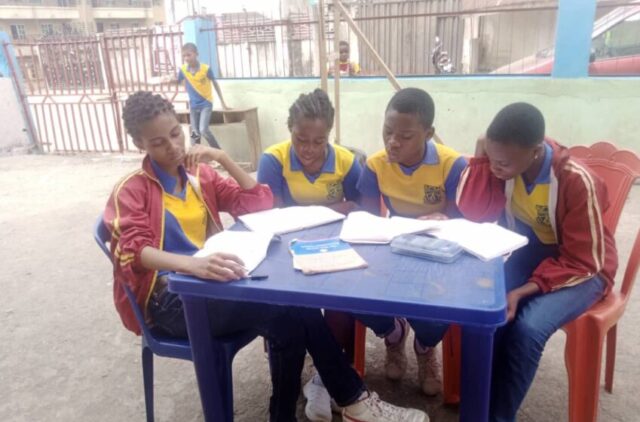
Insecurity in many parts of Nigeria has led to the displacement of families and the shutting down of schools. This has sent many girls out of school and to the streets, crushing their dreams as they struggle to fend for themselves and their families through street begging and other forms of child labour. In this report, NCHETACHI CHUKWUAJAH looks at the socio-economic and other implications of insecurity on girl-child education in Nigeria.
Every day, Halimatu Sadia sits on a concrete slab near a filthy corner at the Ojoo flyover in the southeast of Ibadan, southwest Nigeria. Armed with a plastic bowl, a black jute bag where she keeps her belongings and dressed in near-rag clothing, she calls out to passers-by, especially the well-dressed ones, begging for alms.
Halimatu was not always like this. Her village, Gandi, in Niger State, Nigeria’s northcentral, was one of the communities attacked by bandits in January this year. Sadia was lucky to escape, but other residents of the village were not. Her neighbours and a number of other people were murdered, forcing members of her village to flee. She has a bullet scar on her left arm from an injury she sustained during the attack.
Schools in Halimatu’s community were shut down following the attack, and kids were pulled out of class, she claims. This is even as some of the attacks in her state have targeted schools. Halimatu is afraid to send her children back to school for fear of being kidnapped or, worse, killed because the violence she witnessed is deeply ingrained in her mind.
“Yes, we want to send our children to school, but we don’t have the resources now. If it is in the North, if we take a child to school, the child may be kidnapped. Even the teachers in the schools were not spared by the kidnappers. Why would I carry a child that I have suffered for nine months before I gave birth to him/her to the school for that child to be kidnapped?”
“That is why we don’t want to take our children to the conventional school now, with the current situation of things. We would rather send them to the Arabic schools that they attend in the evenings,” Halimatu told Nigerian Tribune in Hausa.
Halimatu is not the only person who has this thought. Like her, Aisha Garba prefers for her kids to go to Arabic schools that are much closer to her house.
“We are refusing to send our children to school, especially in the north, because we can’t be struggling to cater for our children’s welfare only to take them to school and have them kidnapped,” Aisha expresses, “It is better that our children stay at home with us and attend the Arabic schools close by in the evenings and come back to us at home.”
Halimatu and Aisha’s concerns are understandable and very real, given the recent trend of terrorists’ and bandits’ attacks targeting schools, especially in northern Nigeria.
Since the Boko Haram sect’s wave of terrorist attacks began in Nigeria in 2011, several attacks have been launched against schools that the group has decried as “haram,” or evil.
The challenge of insecurity in Nigeria
The United Nations Children’s Emergency Fund (UNICEF), in commemoration of the eighth anniversary of the first school attack in Nigeria on April 14, 2022, noted that since December 2020, 1,436 schoolchildren and 17 teachers have been kidnapped, while 16 of those schoolchildren lost their lives. The Fund also stated that in 2021 alone, 25 schools were attacked by suspected terrorists.
A report released by SBM Intelligence in September 2021 revealed that between March 2020 and September 2021, 1,409 students and 17 teachers were abducted from various schools across Nigeria in 19 incidents of attacks, including in Katsina, Niger, Kebbi, Zamfara, Kaduna and Plateau States. The report also revealed that at least N220 million (USD 496,421.56) was paid as ransom.
These attacks have not only disrupted school activities but have discouraged school enrollment. This is evident in the downward enrollment of children in school, girls particularly, especially after the April 14, 2014 attack on the Chibok Government Girls’ Secondary School in Chibok, Borno State, where 276 schoolgirls were kidnapped by suspected members of the Boko Haram sect.
Since the infamous Chibok School girls’ abduction, many other targeted abductions and school attacks have been recorded. On February 19, 2018, about four years after the Chibok abduction, 110 students of Government Girls Science Technical College were kidnapped. On December 11, 2020, 303 schoolboys of Government Science Secondary School, Kankara in Katsina State were taken captive by bandits. A few days later, on December 19, 2020, a stalled kidnap attempt was made on 80 Islamic school students in Dandume, Katsina State.
On February 12, 2021, 42 persons, including students, teachers and their families, were kidnapped from Government Science College, Kagara, in Shiroro Local Government Area of Niger State. On February 26, 2021, 317 schoolgirls were kidnapped by gunmen from Government Girls Science Secondary School, Jangebe, Zamfara State. Thirty-nine students of the Federal College of Forestry Mechanisation, Afaka in Igbabi area of Kaduna State were kidnapped on March 11, 2021.
At least 20 students and two staff were kidnapped on April 20, 2021 from Greenfield University, Chikun Local Government Area of Kaduna State. Dozens of students on May 30, 2021 werekidnapped from an Islamic school in Niger State. On June 17, 2021 many schoolgirls were kidnapped from Federal Government College, Birnin Yauri, Yauri in Kebbi State. On July 5, 2021, 121 students of Bethel Baptist High School, Maraban Damishi, Kujama in Chikun LGA of Kaduna State were kidnapped in the wee hours of the morning. Over 100 students were also abducted from Government Day Secondary School, Kaya in Maradun LGA of Zamfara State.
Many other school attacks have since occurred in 2022. In fact, the incessant attacks by suspected terrorists have led to the shutting down of about 11,536 schools across many states in northern Nigeria since December 2020.
While some of the kidnapped students and teachers have been freed – sometimes after paying ransom to their captors – and others have been murdered, the impact and message of these kidnappings have left much to be desired.
Insecurity threatening school enrollment as many children of school age are out of school
“We have heard of how they have been kidnapping school children,” Aisha Garba told Nigerian Tribune, “They kidnap them, hide them and demand ransom, sometimes N1 million (USD 2,256.29) for the parents to pay.”
She continued: “For those of us who don’t even have food to eat or know where will we source that N1 million (USD 2,256.29) for the release of any of our children if they are kidnapped it is impossible what they are asking from us.”
Giving credence to Aisha’s worries, Rahma Farah, the head of the United Nations Children’s Emergency Fund (UNICEF) office in Kano State, told reporters in May 2022 that “These attacks have created a precarious learning environment and discouraged parents and guardians from sending their children to school.”
The result of low school enrollment is the burgeoning number of children who are out of school in Nigeria, which the United Nations Educational, Scientific and Cultural Organisation (UNESCO), ina report released in September 2022, estimates to be 20.2 million.
In May 2022, UNICEF said that 60 per cent of the 18.5 million children in Nigeria who are out of school are girls. The UNICEF data is eight million more than the 10.5 million that the Fund disclosed in 2021.
Girl-child education will contribute significantly to countries’ GDP
In 2015, world leaders signed the Sustainable Development Goals (SDGs) with a commitment to take steps to improve girls’ education by 2030 through SDGs Goal Four – Quality Education. However, many countries, especially in sub-Saharan Africa, are still below par with regard to girl-child education despite the huge benefits accruable from it.
The World Bank, while highlighting the benefits of girls’ education, averred that: “Better educated women tend to be more informed about nutrition and healthcare, have fewer children, marry at a later age, and their children are usually healthier, should they choose to become mothers. They are more likely to participate in the formal labour market and earn higher incomes.”
A study by the Bank in 2018 found that limiting educational opportunities for girls and barriers to completing 12 years of education “cost countries between $15 trillion and $30 trillion in lost lifetime productivity and earnings.”
A 2020 report by the rights group, Plan International, in collaboration with Citi’s Global Insights, shows that for every $1 spent on girls’ rights and education, low to middle-level countries would generate a $2.80 return to the country’s Gross Domestic Product (GDP).
The report examined eight countries: Uganda, Egypt, Bolivia, India, Mali, Ghana, and others. It found that ensuring all girls are finishing secondary education by 2030 would boost countries’ GDP by 10 per cent on average over the next decade.
It noted that guaranteeing women’s and girls’ inclusion and empowerment may be the key to achieving all of the SDGs in record time, given its potential to stimulate economic growth and eradicate poverty.
In an interview with AWiM News, Dr Ukwueze Ezebuilo, a Senior Lecturer in the Department of Economics, University of Nigeria, Nsukka said, “Child-begging is trading-off education because the time girls are using to beg, is the time they should be in the classroom learning,”
“This ravages the economy because these children will grow up to become unemployed and be limited when it comes to contributing to the economy,” He explains.
Education is key to the development of core skills needed in different sectors where young girls can grow up to become workers with qualifications and also entrepreneurs.
“The productivity of the economy falls when those who would have been trained in school, are not trained and find they cannot produce or contribute to the economy which results in the economy, which would have grown, being retarded,” Dr Ukwueze Ezebuilo states, “The benefits of investment in girl-child education are not doubted, it has a multiplier effect.”
Governments’ policies should be child-friendly to boost education
Beyond the socioeconomic issues that have caused a rife of child labour, according to Dr Tade Oludayo, a lecturer with the Department of Sociology at the University of Ibadan, governments should take into account children’s rights when drafting policies.
“When we are talking about policies, we, most of the time, don’t incorporate children and what you will hear the government say is that there is an increase when they introduced one policy or the other, like the school-feeding programme. What they are calculating is the number of people that they have on the register, not the number of people that stay in school. It is not about attracting them to school with food, it is about retaining them in school.
“We can’t just be saying children are the future and we are destroying our future by not taking care of them. We need to incorporate into our policy focus and formulate child-friendly vocational education there in their schools. Then, we will have people who, from childhood, are earning income with their skills.
“Formal education is by the side and informal education can then begin to turn around our economy because we now have productive youths because in their consciousness they know they have what the society needs,” Dr Oludayo told AWiM News.
Dr Oludayo said that the implication of exposing children to labour of any sort for society is huge: “It is not only dangerous for the present day Nigeria but also for the future because we are fearing children who will become a terror to all of us in the future.”
“We should not be more interested in using statistics about school enrollment than school retention,” He adds, “We should be more concerned about those who stay in school to learn because when they learn in school, their mentality is reformed and shaped to become good members of society. But when they are on the streets, they are exposed to all sorts of things.”
The danger in this for the lecturer comes when the belief that going to school still results in limited opportunities is spread in society: “It will be difficult in a society where people are barely coping with existential realities and where children do not have a good standing in terms of our policy focus and policy capture of them,” he explains.
Acquiring an education puts girls in a good stead – Educator
Mrs Modinat Oyeleye, Counsellor at St Teresa’s College (Senior School), Oke-ado, Ibadan, noted that the saying “Train a girl, build a nation,” is not any truer given the benefits derivable from girl-child education.
She continues: “A girl without education has nothing to offer to society, she will grow up to become a burden to society and give birth to others who will also become burdens unless there is a timely intervention or miracle.”
When a girl is educated and no opportunity comes, the counsellor believes there is still hope: “Opportunity can come tomorrow or at any time, it is not academic education alone; you can learn a trade or acquire a skill, they are all part of education,” she states, “It is about getting something that you can beat your chest about, something that you can stand on and face whatever challenges may come.”
Mrs Abiade Abiola, a lecturer of law with Lead City University, Ibadan and president of the Human of Substance Empowerment Initiative (HOSEI), told the AWiM News that securing girls’ future through education holds more potential for the nation than whatever contribution they make to their families through street begging.
“We shouldn’t look at the one-directional aspect of it by saying they are bringing in money,” she tells us, “We need to think about their futures and the disadvantages and permanent effects exposing children to child labour has on their lives.”
She asks: “Is it not too grave a crime to pay for the momentary elimination of poverty? At the end of the day, how much do they really bring in?”
Lessons from Africa
Some African countries like Ghana, South Africa, Kenya, and Egypt, have made strides in education with lessons for Nigeria on how investing in girl-child education can be a game-changer.
A recent ranking by the World Economic Forum involving 140 countries, including 38 African countries, shows that Nigeria is not among the top 10 African countries where quality education can be imparted. Cape Verde, ranked eighth in Africa, was the only West African country on the list.
Seychelles, Tunisia, Mauritius, South Africa, Algeria, Botswana, Kenya, Egypt and Namibia made it to the list in that order. They were ranked on skill development, labour competence, amount of quality schooling, and digital literacy, among other indices.
The ranking, reported by Business Insider Africa, also found that the countries, especially Seychelles, which is 43rd in the world, prioritised the SDGs’ Goal Four by adopting UNESCO’s “Education for All” charge and investing significantly in education. UNESCO, in what is now popularly called the ‘Dakar Framework,’ had recommended in 2000 that countries should show commitment to education by allocating 15-20 per cent of annual budgets to the sector.
The report noted that Tunisia allocated 20 per cent of its national budget to education, while Mauritius made schooling compulsory up to the age of 16. Literacy rates in Algeria and Kenya are 75 and 78.7 per cent, respectively, with Kenya allocating 17.58 per cent of its budget to education. Egypt and Namibia’s respective literacy rates are 71 and 88.2 per cent.
In the case of Nigeria, the country has not met the UNESCO 15-20 per cent budget allocation threshold in the last decade. The highest allocation was in 2015 when 10.7 per cent of the year’s N4.5 trillion (USD 10.154 billion) budget was allocated to the sector.
Out of a budget of N6.06 trillion (USD 13.673 billion) in 2016, N480.28 billion (USD 1.084 million), representing 7.9 per cent, was allocated to education. The sector’s allocation decreased to 6.1 per cent of N7.30 trillion (USD 16.472 billion) in 2017; increased to 7.1 per cent of N9.2 trillion (USD 20.760 billion) in 2018 and increased to 8.4 per cent of N8.83 trillion (USD 19.925 billion) in 2019.
The sector got 6.5 per cent of the 2020 national budget, 5.6 per cent in 2021 and 5.4 per cent of the N17.13 trillion (USD 38.651 billion) 2022 budget.
Like most experts have averred, Nigeria’s walk towards empowering girls for economic stability through education must begin with a strong determination and commitment by the government at all levels to address the factors that take girls out of school, chief of which are insecurity and poverty.
There is also an evident need to increase funding for the education sector, to increase the formulation of policies that take cognisance of and address girls’ educational needs. Ones that priortise safety measures in schools so that learning is not a risky venture for girls.
This story was supported by African Women in Media, as part of the Reporting Violence Against Women and Girls Initiative.













